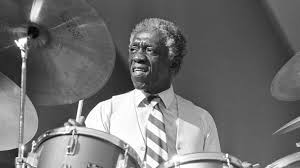Art Blakey, a legendary figure in the history of jazz, left an indelible mark on the genre as both a drummer and a bandleader. He is best known for his powerful, rhythmic drumming style and his work with his influential band, The Jazz Messengers. Here are five fascinating curiosities about Art Blakey, a pioneer of hard bop:
1. Blakey’s Transformation to Islam and Name Change
In the 1940s, during a trip to Africa, Art Blakey converted to Islam. After this spiritual journey, he adopted the name Abdullah Ibn Buhaina. While his public and professional life continued under the name Art Blakey, those close to him sometimes referred to him by his Islamic name. This transformation deeply influenced his outlook on life and his music, infusing his work with a more global and spiritual consciousness.
2. The Birth of The Jazz Messengers
Art Blakey formed The Jazz Messengers in the 1950s, a group that would become a seminal institution in jazz history. The band not only became known for its signature hard bop sound, but it also served as a launching pad for numerous young jazz musicians. Icons like Wayne Shorter, Freddie Hubbard, Lee Morgan, and Wynton Marsalis all honed their craft with Blakey’s group. Through The Jazz Messengers, Blakey nurtured generations of jazz talent, ensuring the continued evolution of the genre.
3. Blakey’s Signature Drumming Style: Thunderous and Melodic
Blakey was renowned for his distinctive drumming style, characterized by his powerful, thunderous approach, yet always deeply melodic and intricate. One of his most famous techniques was the use of press rolls—a continuous, rolling drum sound—that he played with precision and intensity. His dynamic drumming often served as a driving force in his band’s performances, providing both rhythm and a form of musical expression that went beyond mere accompaniment.
4. A Heart of Mentorship
Art Blakey wasn’t just a bandleader; he was a mentor and educator who had a profound impact on the careers of young musicians. He viewed The Jazz Messengers as a finishing school for jazz musicians, where they could learn, develop their own styles, and eventually move on to lead their own bands. Blakey’s willingness to nurture new talent contributed to his enduring legacy, as many of his former band members became jazz legends in their own right.
5. Performing Into His 70s: The Energizer of Jazz
Even as he aged, Blakey remained an energetic and vital force in the jazz world. He continued to perform well into his 70s, showing no signs of slowing down. His physical stamina and passion for the music were legendary, often performing with the same intensity and energy that defined his earlier years. His dedication to jazz until the end of his life exemplified his deep love for the art form and his unwavering commitment to pushing the genre forward.
Conclusion
Art Blakey’s influence on jazz cannot be overstated. From his early spiritual transformation to his mentorship of future jazz icons, Blakey’s life was full of remarkable moments and contributions to the music world. His thunderous drumming, nurturing leadership, and devotion to jazz made him one of the most important figures in the history of the genre. Through these curiosities, we see Blakey not just as a musician but as a pivotal force in shaping the sound and direction of jazz for decades.


Comments are closed